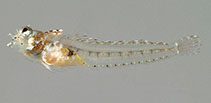| Family: |
Chaenopsidae (Pike-, tube- and flagblennies) |
| Max. size: |
2 cm SL (male/unsexed) |
| Environment: |
reef-associated; marine; depth range 1 - 8 m |
| Distribution: |
Western Central Atlantic: Belize, Honduras, south to Panama; on the islands of the western Caribbean, including San Andres and Cayman Islands; across to the northern Antilles: Mona Island, Puerto Rico, and St. Croix, St. Barthélemy, and Isla Aves, but stopping before Dominica. Apparently absent from the southern Caribbean east of Panama, i.e. Colombia, Aruba, Bonaire, Curaçao, Venezuela, Trinidad, and the Windward (southern) Lesser Antilles (Dominica, Martinique, St. Lucia, Barbados, St. Vincent and Grenadines, Grenada, and Tobago); to the north, absent from the Gulf of Mexico, Florida, the Bahamas. |
| Diagnosis: |
Dorsal spines (total): 19-21; Dorsal soft rays (total): 10-13; Anal spines: 2-2; Anal soft rays: 19-21. This species with an orbital cirrus and no red banner is distinguished by the following characters: TP territorial males found in holes with a black head; the anterior dorsal fin black, with a short, thin, white margin reaching back to second membrane; the first two membranes well incised; first dorsal-fin spine relatively short, when adpressed reaching to about 5th-6th spine base, about 1/2 HL, the third and fourth spines are also shorter, subsequent spines rising to midfin spines (Ref. 125603).
Dark-shaded and transitional TP with a relatively short first dorsal-fin spine, the second spine usually equal, with third spine about 2/3 of first, the fourth spine less than 1/2 first spine, and tenth spine about equal to first, profile of anterior dorsal fin with a moderate concavity, decreasing during transition; the first three dorsal-fin membranes white tipped, tips rounded and membranes incised; usually distinct large head spots; a prominent characteristic black spot a third way along the lower lip; without dense speckling of dorsal-fin and pectoral-fin membranes; row of dark spots along lateral midline adsent, no rows of dark spots along proximal spinous-dorsal-fin membranes, and no opercular bands or lines (Ref. 125603).
IP with elongated first two dorsal-fin spines, the first spine when adpressed reaching to base of 5th-8th spine base, the second spine about equal, the third about 2/3 of first, first two membranes with white rounded tips. Colouration: live colors greenish blue and gold; the cranial pattern of bluish spots and reticulations with a greenish gold background; IP head spots are usually reduced; melanophores near pectoral-fin base with a short oblique band to none (Ref. 125603) |
| Biology: |
|
| IUCN Red List Status: |
Least Concern (LC); Date assessed: 18 October 2007 Ref. (130435)
|
| Threat to humans: |
harmless |
Source and more info: www.fishbase.org. For personal, classroom, and other internal use only. Not for publication.

